Aangemaakte reacties
-
AuteurBerichten
-
Ook Nederland dumpt deel staatsobligaties VS
Uit de cijfers van het Amerikaanse ministerie van Financiën blijkt Nederland Amerikaans schuldpapier te hebben verkocht. In de laatste zes maanden van 2010 stootten Nederlandse partijen $2 miljard af. In de periode juni-december 2010 werd het belang teruggebracht van $24,7 miljard naar $22,7 miljard; een afname richting de 10%.
Saillant detail is dat de Amerikanen onlangs de wijze van berekenen hebben gewijzigd. Wie de cijfers afkomstig uit de oude berekeningswijze erop na slaat, ziet dat Nederland een aanzienlijk deel van het Amerikaans schuldpapier verkocht heeft. In december 2009 stond er namelijk bij Nederlandse partijen nog voor ruim $20 miljard aan Amerikaanse staatsobligaties in de boeken; in december 2010 bleek daar nog slechts 15 miljard van overgebleven. Dat is een afname van maar liefst 25%.
Bron: http://goud.com/
http://www.pimco.com/Pages/Two-Bits-Four-Bits-Six-Bits-a-Dollar.aspx
Attachments:
Wie_koopt_staatsobligaties_VS.jpgHoe veilig zijn de Europese staatsobligaties? Een overzicht van de staatsschuld van diverse landen.
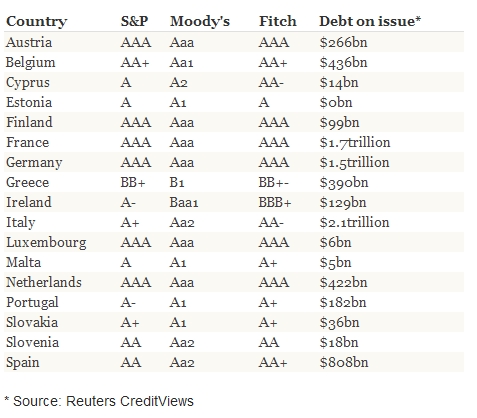
Bron: http://www.telegraph.co.uk/finance/economics/8374481/How-safe-is-Eurozone-sovereign-debt-table.html
• Een bewogen week op het gebied van grondstoffen.
• Grondstofprijzen staan onder druk door slechtere cijfers dan voorspeld uit China en Amerika over economisch herstel. Ook de aardbeving in Japan en problemen met staatsobligaties in Europa spelen mee.
• De DJ UBS index kampt met het ergste verlies sinds November, lagere aandelenmarkten schrikken risicovolle beleggingen af.
• Ruwe olie liep afgelopen vrijdag aan tegen winstnemingen.Na de recente oliepiek sloeg de aandacht om van de onzekerheid op het gebied van levering naar onzekerheid over de vraag.
• Zilver groeide 11% en bereikte daarmee deze week het hoogste punt in 30 jaar, totdat het algemene risicoprofiel verminderd werd, dit leide tot winstnemingen.
• Goud wist te herstellen na de correctie in januari. Na een record hoogte te hebben bereikt, wordt er nu nog slechts zijdelings in gehandeld.
• Graan en andere oliehoudende zaden verloor 16% op de speculatieve positie, sinds de piek in begin februariA week of heavy liquidations in commodities
Commodity prices have been undermined by the risk of an economic slowdown with softer than expected Chinese and US data, earthquake in Japan and renewed focus on the sovereign debt problems in Europe.
The DJ UBS index suffered its heaviest defeat since November as lower stock markets reduced the appetite for riskier investments. The heaviest losses were seen in agriculture and base metals.
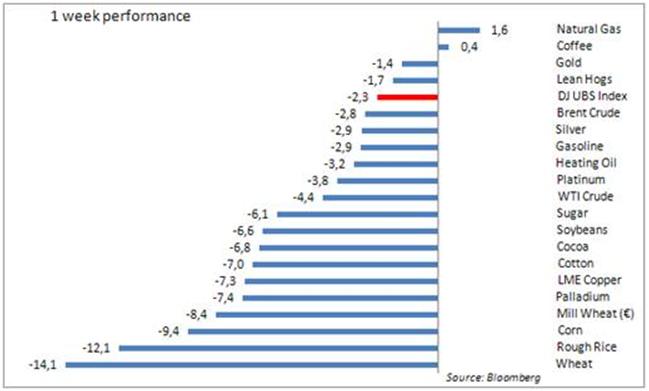
Crude
Crude oil ran into heavy profit taking on Friday as focus switched from supply concerns to uncertainty about demand after the recent spike in prices. The weekly inventory data saw another jump in crude stored at Cushing, the delivery hub for WTI crude, to a new record above 40 million barrels. This inventory jump caused the spread to Brent crude to widen back above 10 dollars, after having contracted from 16 dollars at the outbreak of the Libyan unrest.
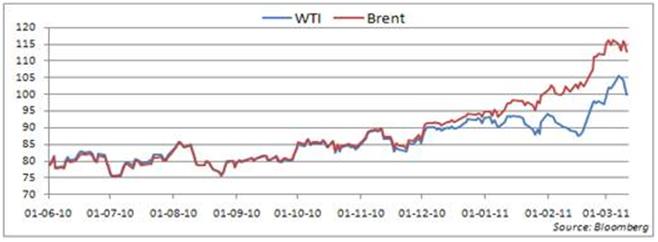
WTI volatility is staying at elevated levels with 30-day trading at 30% which is double early January levels but only 6% higher than the average for the past year. With the market having priced in the effects of the Libyan supply disruption, speculative longs will be looking for additional news to keep prices elevated. The latest CFTC data shows that hedge funds and large investors held 300 million barrels long position of WTI. This is very likely to have triggered the setback this week as no additional news about supply disruption emerged. After the break below $100 WTI crude for April delivery should find major support towards $95.
Silver
Silver has now rallied 11% year to date and reached a 30-year high this week before general risk reduction led to profit taking. Global supplies have tightened as silver enjoys dual attention from industrial users and investors looking for a store of value or a hedge against inflation.
On that basis many, whether correct or not, have come to the conclusion that no matter what happens silver will continue to be in demand. As a result we have now seen silver outperform gold by more than 40% since last August with one ounce of gold then buying 68 ounces of silver against only 40 ounces today.
The bulls have their sight on the old record at 50 dollars from 1980 which was brought about by the Hunt Brothers cornering the market during a time of galloping inflation.
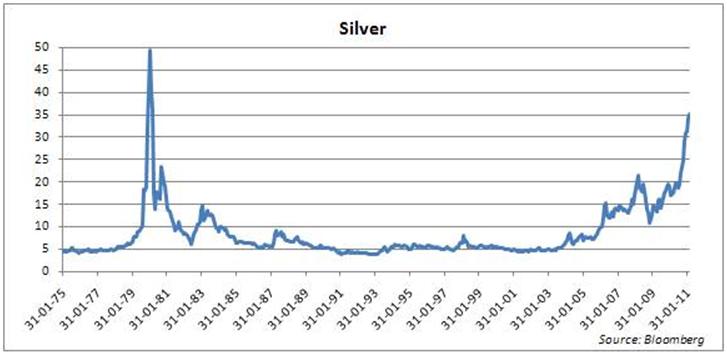
Gold
Meanwhile gold has managed to recover since its January correction, and after reaching a new record high, it has been trading sideways during the past week. This has all happened during a time where the unrest in Libya has increased and the risk of a sovereign debt default in Europe is once again drawing investors’ attention. This indicates that while investors do not have any desire to sell there is no major urgency to buy either.
Investment flows into Exchange Traded Products have picked up while hedge funds and large investors have increased their long positions via futures. These are positive developments for the bulls but as we approach the end of U.S. quantitative easing in June the next move from the U.S. Federal Reserve will become very important as a QE3 will be supportive while a return to higher interest rates could be negative for gold.
Grain and oilseed
The grain and oilseed sector has seen a 16% reduction in the speculative long position since the peak in early February. Talk of fund managers shifting out of agriculture into other sectors combined with a slight improvement in the global supply and demand outlook has helped the move lower. The dollar has recovered from its recent lows thereby also putting some downward pressure on prices. According to recent data from the CFTC, hedge funds and large investors held 851,000 futures lots in grains and the soybean complex, is still at a very elevated level from last year with investors particularly holding onto corn, given the prospect for very low stocks.
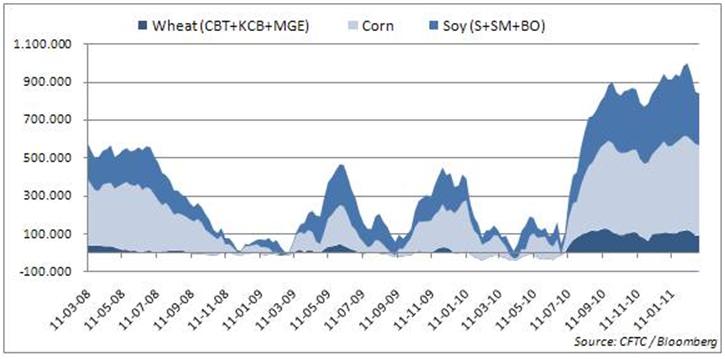
Soybeans
Soybeans have come under some pressure on expectations of a bumper crop in South America which is on track to break the record from 2010, thereby lifting the forecast for a bigger global stockpile of the world’s most used oilseed. Near month corn prices have benefitted from the ethanol link to higher gasoline prices and have outperformed wheat by 18% this past month.
Wheat and Rice
The outlook for wheat somewhat hinges on growing conditions in the North China plains where dry conditions have raised doubt about the current crop. The price in Chicago however has now retraced by 22% from the February high and this week had its biggest weekly loss in more than two years as
the USDA raised its inventory estimate by 4.1 million tonnes. Meanwhile, the price of rough rice has retraced by almost a quarter from those highs as the USDA expects global stockpiles to rise to the highest level in eight years, thereby easing the heightened tension about food security.
Cocoa
Cocoa futures dropped by 7% over the past week on signs that the politically motivated export ban out of the Ivory Coast, the world’s largest producer, is not having the feared impact as supplies from other sources are reaching the market. Ghana, the second largest producer, is expected to raise output by 42% during the current season and global production as a whole is expected to exceed demand.
Coffee
Coffee on the other hand has been rallying hard on the back of expectation that global supplies of high quality coffee will not satisfy demand. Inventories held by exporting nations are at forty year lows with the market failing to react to a surprise jump in coffee production from Columbia. Producers are therefore reluctant to sell as they anticipate even higher prices ahead.
Base metals
The LME composite index, which comprises the six major traded base metals, dropped 6% over the past week as declines across the metal sector saw the index move into a negative return for the year. The uptrend from June 2010 has come under some considerable pressure but is still holding at the time of writing this piece.
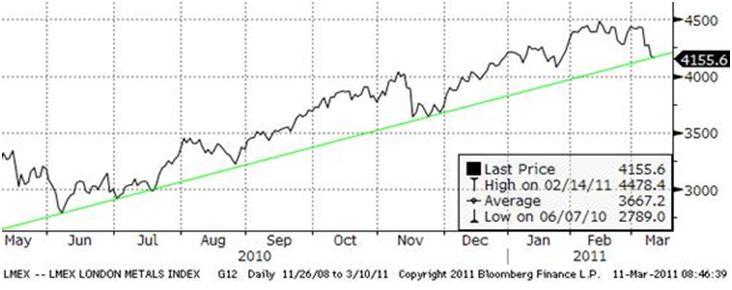
Worries about softer Chinese demand in the coming months combined with risk adversity from the MENA crisis have done most of the damage to prices. Copper, the most widely used metal, fell to the lowest price since December as Chinese imports fell to a two-year low in February. China’s share of global copper consumption stands at 40% but how much of this drop was related to the Lunar New Year holiday remains to be seen as a government department in a report stated that imports will remain at “relative high levels” during 2011.
Bron: Saxo Bank
mooi he op een verjaardag, dank voor je mail Satilmis.En sorry voor mijn weinige postings op dit forum.Maar ik heb weinig bij te dragen met mijn beperkte kennis tussen de geweldenaren op dit forum .en die geweldenaren waardeer ik zeer .
groet
9 maart 2011 om 19:26 In reactie op: Afstudeeronderzoek, Beleggen tijdens de crisis #link naar dit berichtTim, wil je de resultaten ook hier publiceren? Lijkt me interessant.
Amerikaanse staatsobligaties massaal gedumpt!
Bill Gross van Pimco, de grootste obligateibelegger ter wereld dumpt Amerikaanse staatsobligaties, brengt het belang terug naar 0!
Vandaar is de lange rente gestegen? Geen QE3 op komst?
Bill Gross Dumps All Treasuries, Brings Total “Government Related” Holdings To Zero, Flees To Cash – No QE3?
And many thought Bill Gross was only posturing when he said he is getting the hell out of dodge. Based on still to be publicly reported data by Pimco’s flagship Total Return Fund, the world’s largest bond fund, in the month of January, has taken its bond holdings to zero (and -14% on a Duration Weighted Exposure basis).
The offset, not surprisingly, is cash. After sporting $28.6 billion in “government related” securities, TRF dropped to $0.0, while its cash holdings surged from $11.9 billion to a whopping $54.5 billion (based on total TRF holdings of $236.9 billion as of February 28).
This is the most cash the flagship fund has ever held, and the lowest amount in Treasury holdings since January 2009 before it was made clear that the Fed was going to adjust QE1 to include Treasurys in addition to Mortgage Backed Securities.
PIMCO’s Treasury holdings peaked in June 2010 at $147.4 billion and have declined consistently ever since. And while we expected that the spike in MBS holdings (at times on margin) was indicative of an expectation that QE3 would monetize mortgage backed securities, the ongoing decline in that asset class now leads us to believe that Bill Gross is now convinced there will be no QE3 at all, at least based on his just putting his money where his monthly pen is!
And if Bill Gross, the most connected person to the upcoming actions by the Fed, believes there is no more quantitative easing, it is really time to get the hell out of dodge in all security classes – bonds, and most certainly, equities.
De “bull markt” is jarig. Exact 2 jaar geleden op 194,99, rond 10.30 uur. Een winst van +88,63% ten opzichte van vandaag.
@zonderland Wij hebben al een draadje lopen rond nexttrades. Ik heb jouw reactie daarom naar hier verplaatst.
• Hogere olieprijzen laten aandelenmarkten koud;
• De crisis in Libië escaleerde afgelopen week waardoor meer dan de helft van de olieproductie uit de markt is verdwenen;
• Europese Bank verrast met hint naar renteverhoging op korte termijn om de inflatie te beteugelen;
• Oliemarkten blijven reageren op krantenkoppen over de ontwikkelingen in het Midden – Oosten en Noord Africa;
• De voedsel- en landbouworganisatie van de VN’s index voor mondiale voedselprijzen is gestegen tot een recordhoogte in februari;
• Katoen en suiker maken een sterk herstel door, na de recente correctie;
• Goud klom weer naar een record van 1.440 dollar, voordat er nieuws kwam over de waarschijnlijke stijging van de rente in Europa;Bron: Saxo Bank
Willem, welkom terug!

Voor wie geïnteresseerd is in forex trading heb ik een nieuw subforum aangemaakt: http://forum.dekritischebelegger.nl/forum/forex-trading/
@mereoc, bedankt voor je suggestie. Ik sta altijd open voor ideeën.
Op zich is dat best interessant maar ik ben er een beetje klaar mee :-). Maar als het op een neutrale manier kan, lijkt het mij een goed plan.
Belangrijk is uit te gaan van je eigen kracht van dit forum. Forumleden bepalen die kracht door hoe ze met elkaar omgaan.
Wij hadden vroeger dagdraadjes: http://forum.dekritischebelegger.nl/forum/dagelijkse-discussie/.
Is het misschien een idee om elke dag een nieuw draadje te beginnen met de ontwikkelingen van die dag? Nieuwsberichten (met bronvermelding), cijfers, ingenomen posities etc. mogen geplaatst worden.
Hier kunt u alle reacties kwijt wat betreft economisch nieuws.
@pingpong goed nieuws: Edward Loef gaat voor ons schrijven:
http://forum.dekritischebelegger.nl/aandelen/beurzen/aex/nieuwe-columnist-edward-loef/
25 februari 2011 om 22:06 In reactie op: winstgevend beleggen op lange termijn illusie? #link naar dit bericht@mevlana de kans op geld verliezen neemt exponentieel toe als je niet weet waar je mee bezig bent.
@pingpong Vroeger werden vrouwen voor heks uitgemaakt als de pest uitbrak of mensen op de brandstapel gezet, gevierendeeld of geradbraakt. Veel mensen juichten die executies toe en sommigen zwijgden.
Ik erger me aan eenzijdige berichtgeving en het is geen promotie-verhaal geweest. Ik geloof dat ik de belangrijke vragen gesteld heb. Mensen moeten zelf lering uittrekken. Zolang het adagium van deze samenleving “apathie is een deugd” is, zal het wellicht vergeefs zijn geweest. Mensen moeten studeren, hard werken om iets te bereiken.
Noach schreef:
Je hebt iets vies opgepakt en nu probeer je vergoelijken. Iets vies oppakken is niet niet erg. Een besmet persoon als gb is vragen om problemen mijn vraag is waarom kies je voor de smet en niet voor de schoonheid?Nu de vraag de smet en de smerigheid of de keuze voor de schoonheid van de kunst.
Reik de hand strek wat kies je?
Ik kies voor de schoonheid van de kunst!
-
AuteurBerichten

